[管理学]国际财务管理第5章
国际财务管理第五章

國際財務管理—跨國企業之價值創造
謝劍平 著
ISBN 978-957-41-8273-2
外國貨幣應付帳款之避險策略釋例
甲公司在3個月後需要支付一筆100萬歐元的貨款,若其有多 餘的現金,即可在銀行存入一筆3個月期的歐元定期存款,假 設目前的利率為3.65%,則甲公司必須存入990,958歐元。
若目前歐元兌新台幣的即期匯率為44.9(NTD/EUR),則需使用 新台幣44,494,014元[=EUR990,958×44.9(NTD/EUR)]來換購 這筆歐元。
(R
t 1
n
1, t
R1 ) (R 2, t R 2 )
2
(R
t 1
n
1, t
R1 )
(R
t 1
n
2, t
R 2 )2
由上式可知貨幣組合的標準差並非兩貨幣標準差的加權平均值 ,而必須考量組合內個別貨幣的連動性(通常以共變異數或相 關係數衡量)。
國際財務管理—跨國企業之價值創造
謝劍平 著
ISBN 978-957-41-8273-2
表5-4 外匯期貨之多頭避險
日期 目前 現貨市場 3個月後需要支付100萬歐元 擔心未來歐元兌美元升值 即期匯率 = 1.4967 (USD/ EUR) 3個月期遠期匯率 = 1.5(USD/EUR) 以美元兌換100萬歐元 即期匯率 = 1.51(USD/EUR) 1,000,000 X (1.51-1.5) = USD 10,000 採購成本增加10,000美元 期貨市場 買進8口歐元期貨 3個月後到期之歐元期貨 價格= 1.5(USD/EUR) 8口歐元期貨到期 歐元期貨到期價格 = 1.51(USD/EUR) 8 X 125,000 X (1.51 – 1.5) = USD 10,000 期貨部位獲利10,000美元
国际财务管理精选课件

(二)通货膨胀对财务状况的影响
1.东道国通货膨胀会对在该国经营的子公司 的财务状况造成一系列的影响:
实物资产重置成本增加 货币性资产贬值 货币性负债获得收益 收益虚增 2.国际企业难以设计转移定价
三、金融市场
储蓄 资金
金融机构:
商业银行 储蓄银行 信用合作社 保险公司 养老基金
贷款 资金
三、风险价值的计算
1、确定概率分布
概率:指某一事件可能发生的机会,用Pi表示。 Pi的条件:0≤Pi≤1 ;ΣPi=1 。 例:某公司有两个投资项目,大发银行与富商地产,其
基本情况如下:
经济情况 繁荣 一般 衰退
发生概率 0.2 0.6 0.2
银行报酬率 20% 15% 10%
地产报酬率 100% 15% -70%
宣言》 WTO有关规则 欧盟有关条约
第五节 国际财务管理与经济环 境
一、经济制度 国家对国民经济运行的干预程度和所有制的
不同,对会计规范具有重大影响。
二、通货膨胀/紧缩
(一)通货膨胀影响企业现金流 例.某国际企业子公司大量进口某种原材料用于生产 ,产品主要在东道国进行销售。假设东道国发生通货 膨胀,则该子公司的现金流入量可能会发生何种变 化? ——假如东道国货币没有发生贬值,则现金流入增加 ——假如东道国货币贬值,现金流入不一定增加
普通法系和大陆法系的会计制度不同。
会计制度的实施方式也不同。
二、国内法对国际企业的管制
(一)专门针对国际企业 股权比例 分红原则 共同管理 当地成分要求 资本转移 信息披露
(二)并非专门针对国际企 业
税法 公司法 破产法
三、国际法对国际企业的管制
联合国《跨国公司行为准则》 经合组织《经合组织关于国际投资与多国企业的
国际财务管理知识分析及练习题参考答案

国际财务治理?练习题参考答案第1章国际财务治理导论一、名词解释1.国际企业:超越国界从事商业活动的企业,包括各种类型、各种规模的参与国际商务的企业。
国内生产、国际销售是国际企业最简单的国际业务。
跨国公司是国际企业开展的较高时期和典型代表。
2.许可经营:许可方企业向受许可方企业提供技术,包括版权、专利技术、技术诀窍或商标以换取使用费的一种经营方式。
当许可方企业与受许可方企业分不位于不同国家时,就形成了国家间的许可经营。
这种方式也能够被瞧作技术出口。
3.特许经营:是一种特殊的许可经营方式,许可方通过向被许可方提供全套专业化企业经营手段,包括商标、企业组织、销售或效劳策略和培训、技术支持等定期取得特许权使用费,被许可方那么必须同意遵守严格的规那么和程序以实现经营的标准化。
特许权使用费通常以被许可方的销售收进为根底收取。
4.分部式组织:称事业部制组织结构。
其特点是在高层治理者之下,按地区或产品设置假设干分部,实行“集中政策,分散经营〞的集中领导下的分权治理。
5.混合式组织:事实上非常少有哪家企业是单纯采纳一种结构类型的,采纳两种以上组合方式的称为混合式结构。
6.分权模式:子公司拥有充分的财务治理决策权,母公司关于其财务治理操纵以间接治理为主。
二、简答题1.国际财务治理与国内企业的财务治理内容有哪些的重要区不。
【答案】国际财务治理是指对国际企业的涉外经济活动进行的财务治理。
财务治理要紧涉及的是如何作出各种最正确的公司财务决定,比方通过适宜的投资、资产结构、股息政策以及人力资源治理,从而到达既定的公司目标〔股东财宝最大化〕。
国际财务治理与国内财务治理之间的区不要紧表达在以下几个方面:〔1〕跨国经营和财务活动受外汇风险的妨碍;〔2〕全球范围内融资,寻求最正确全球融资战略;〔3〕跨国经营中商品和资金无法自由流淌;〔4〕对外投资为股东在全球范围内分散风险。
2.试述国际财务治理体系的内容。
【答案】国际财务治理体系的内容要紧包括:〔1〕国际财务治理环境。
国际财务管理课后习题答案chapter-5

CHAPTER 5 THE MARKET FOR FOREIGN EXCHANGESUGGESTED ANSWERS AND SOLUTIONS TO END-OF—CHAPTERQUESTIONS AND PROBLEMSQUESTIONS1。
Give a full definition of the market for foreign exchange。
Answer: Broadly defined, the foreign exchange (FX) market encompasses the conversion of purchasing power from one currency into another,bank deposits of foreign currency, the extension of credit denominated in a foreign currency,foreign trade financing, and trading in foreign currency options and futures contracts。
2。
What is the difference between the retail or client market and the wholesale or interbank market for foreign exchange?Answer:The market for foreign exchange can be viewed as a two—tier market. One tier is the wholesale or interbank market and the other tier is the retail or client market. International banks provide the core of the FX market. They stand willing to buy or sell foreign currency for their own account。
国际财务管理教学点-完整版
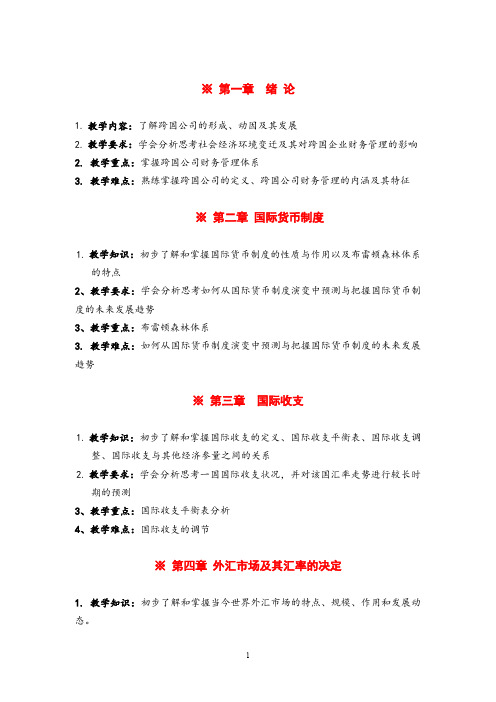
※第一章绪论1.教学内容:了解跨国公司的形成、动因及其发展2.教学要求:学会分析思考社会经济环境变迁及其对跨国企业财务管理的影响2. 教学重点:掌握跨国公司财务管理体系3. 教学难点:熟练掌握跨国公司的定义、跨国公司财务管理的内涵及其特征※第二章国际货币制度1.教学知识:初步了解和掌握国际货币制度的性质与作用以及布雷顿森林体系的特点2、教学要求:学会分析思考如何从国际货币制度演变中预测与把握国际货币制度的未来发展趋势3、教学重点:布雷顿森林体系3. 教学难点:如何从国际货币制度演变中预测与把握国际货币制度的未来发展趋势※第三章国际收支1.教学知识:初步了解和掌握国际收支的定义、国际收支平衡表、国际收支调整、国际收支与其他经济参量之间的关系2.教学要求:学会分析思考一国国际收支状况,并对该国汇率走势进行较长时期的预测3、教学重点:国际收支平衡表分析4、教学难点:国际收支的调节※第四章外汇市场及其汇率的决定1. 教学知识:初步了解和掌握当今世界外汇市场的特点、规模、作用和发展动态。
2. 教学重点:学会即期和远期外汇交易业务及其运作方式3. 教学难点:灵活运用外汇市场基本交易技能为公司解决套期保值达到规避外汇风险的目的※第五章国际银行业务与货币市场1、教学知识:国际金融市场分类及其特点、短期融资工具、欧洲货币市场2、教学重点:欧洲货币市场※第六章国际债券市场学习目标:初步了解和掌握世界债券市场的基本概况、国际债券融资工具的具体操作,区别和比较本国债券、外国债券和欧洲债券之间的异同点,掌握国际债券市场的信用评级以及欧洲债券市场的结构和实务。
教学重点:区别和比较本国债券、外国债券和欧洲债券之间的异同点。
※第八章外汇期货与期权市场1、目标要求:初步了解和掌握外汇期货市场的基本特征;与远期外汇合约的异同;了解并熟悉外汇期权合约的各项技术及特性;学会利用外汇期货与期权市场进行合理避险。
2、习题A、美国某出口商3月10号向加拿大出口一批货物,价值500000加元,以加元结算,3个月后收回货款。
International FinancialManagement 5国际财务管理课件

10
Techniques to Eliminate Transaction Exposure
• If the real cost of hedging is negative, then hedging is more favorable than not hedging. • To compute the expected value of the real cost of hedging, first develop a probability distribution for the future spot rate, and then use it to develop a probability distribution for the real cost of hedging.
• MNCs will normally compare the cash flows that could be expected from each hedging technique before determining which technique to apply.
6
Techniques to Eliminate Transaction Exposure
Chapter 5
Managing Transaction Exposure
1
Objectives
A primary objective of the chapter is to provide an overview of hedging techniques . Yet, transaction exposure cannot always be hedged in all cases. Even when it can be hedged, the firm must decide whether a hedge is feasible. While a firm will only know for sure whether hedging is worthwhile after the period of concern, it can incorporate its expectations about future exchange rates, future inflows and outflows, as well as its degree of risk aversion to make hedging decisions. The specific objectives are to:
国际财务管理

2019/5/14
2
一、财务分析与会计发展
财务分析与会计技术发展
财务分析以财务报表为基础 财务报表以会计技术为基础
2019/5/14
3
会计技术的发展阶段
利用会计凭证记录交易
会计分类账记录交易
编制会计报表
财务报表解释
2019/5/14
4
课堂思考题:财务分析与财务报 表分析的关系
从一般意义而言,人们并不在意财务分析、财 务报表分析的区别,说明其分析的本质是相同 或相近的。但仔细斟酌,它们又有所区别:财 务报表分析的对象是财务报表;财务分析的对 象是财务活动。
2019/5/14
6
二、财务分析应用领域的发展
财务分析开始于银行家
投资领域的财务分析
现代财务分析领域
2019/5/14
7
三、财务分析技术的发展
比率财务分析
1919年,亚力 山大建立比率分 析的系统体系
标准比率分析
趋势百分比
现代财务分析技术
2019/5/14
预测分析、实证分 析、价值评估、电
算化分析
2019/5/14
25
2019/5/14
19
我国财务分析体系与内容构建
见下图
2019/5/14
20
分析概论
分析理论
分析信息
分析方法
会计分析
筹资活动 投资活动 经营活动 分配活动
财务分析
偿债能力 营运能力 盈利能力 增长能力
综合分析
2019/5/14
21
第五节 财务分析的形式与要求
财务分析的形式 财务分析的条件 财务分析的要求
2019/5/14
14
国际财务管理学第六版许艳芳
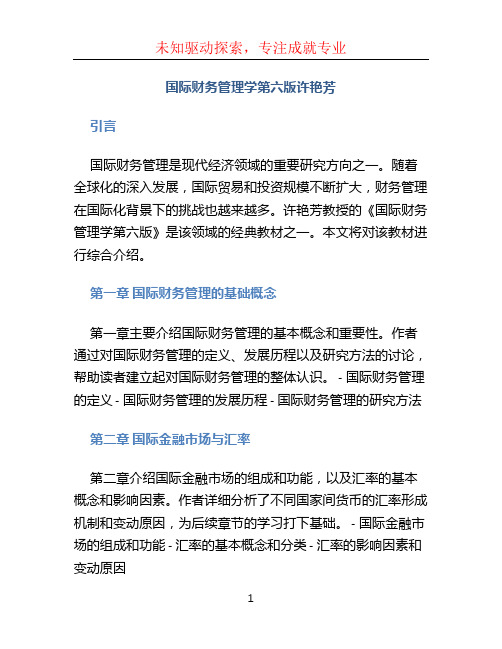
国际财务管理学第六版许艳芳引言国际财务管理是现代经济领域的重要研究方向之一。
随着全球化的深入发展,国际贸易和投资规模不断扩大,财务管理在国际化背景下的挑战也越来越多。
许艳芳教授的《国际财务管理学第六版》是该领域的经典教材之一。
本文将对该教材进行综合介绍。
第一章国际财务管理的基础概念第一章主要介绍国际财务管理的基本概念和重要性。
作者通过对国际财务管理的定义、发展历程以及研究方法的讨论,帮助读者建立起对国际财务管理的整体认识。
- 国际财务管理的定义 - 国际财务管理的发展历程 - 国际财务管理的研究方法第二章国际金融市场与汇率第二章介绍国际金融市场的组成和功能,以及汇率的基本概念和影响因素。
作者详细分析了不同国家间货币的汇率形成机制和变动原因,为后续章节的学习打下基础。
- 国际金融市场的组成和功能 - 汇率的基本概念和分类 - 汇率的影响因素和变动原因第三章跨国公司的财务目标第三章重点讨论跨国公司的财务目标和风险管理。
作者通过对不同财务目标的比较和分析,介绍了传统财务目标与现代财务目标之间的区别和联系,并讨论了跨国公司如何管理汇率和利率风险。
- 传统财务目标与现代财务目标的比较 - 跨国公司的财务目标和风险管理 - 汇率和利率风险管理策略第四章国际金融市场与金融工具第四章重点介绍国际金融市场的各种金融工具和交易方式。
作者通过具体案例分析,帮助读者理解金融市场的运作机制和交易方式,并介绍了国际证券市场、外汇市场和衍生品市场的特点和参与者。
- 国际证券市场和股票交易 - 外汇市场和汇率交易 - 衍生品市场和风险管理工具第五章国际财务报告与分析第五章主要介绍国际财务报告的基本概念和要求,以及财务分析的方法和技巧。
作者通过对国际财务报告准则和标准的解读,帮助读者理解和使用财务报表进行分析和决策。
- 国际财务报告的基本概念和要求 - 财务分析的方法和技巧 - 国际财务报告的解读与分析结论《国际财务管理学第六版》通过系统而全面地介绍了国际财务管理的理论和实践知识。
高级财务管理教学课件第5章国际财务管理

•
A(1+6/12×10%)=1000000 A=95238.95欧元
• 星海国际公司将借到的欧元在即期外汇市场上按照即期汇率1欧元=1.5美 元兑换成1428571.425美元。如果投资时发现:①在美国投资年收益率为
6%;②在欧洲投资年收益率为8%;③在中国投资年收益率为12%。即 只有在中国投资获得的年收益率才能高于借入时的年利率。
上一页
返回
5.3 国际投资决策
• 5.3.1 国际投资的概念和特点 • 1.国际投资的概念 • 国际投资是指投资者跨越国界,投入一定的资金或其他生产要素,以期获得高于
国内收益的一种投资模式。按照投资方式的不同,可以将国际投资分为直接投资 和间接投资。 • 2.国际投资的特点 • 国际投资是国内投资的国际化,主要有以下4大特点。 • (1)多种生产要素的跨国移动 • (2)不一定总有金融资本跨国移动 • (3)周期长,风险大 • (4)直接投资与间接投资(证券投资)往往不能绝对加以区分
26
下一页 返回
5.3 国际投资决策
• 5.3.2 国际投资的方式
• 国际投资的方式很多,一般来说,国际投资方式可以按不同标准进行分 类。
• 1.国际直接投资按进入方式可分为创建企业和收购方式两类 • (1)创建方式 • 这种投资方式是由投资者独立自主经营,独立承担风险的一种国际直接
投资方式。 • (2)收购方式 • 它通常是在不破坏原有市场需要均衡的条件下,获得原有企业的市场占
上一页 下一页 返回
5.1 国际财务管理概述
• 5.1.3 国际财务管理的研究内容
• 国际财务管理研究内容主要包括: • 1.外汇风险管理 • 3.国际投资决策 • 5.国际纳税管理
2.国际筹资管理 4.国际营运资金管理
国际财管英文版第5章
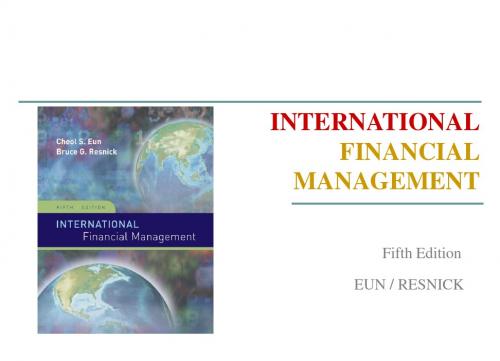
£deposit at B £ 300m B’s Deposit $1,000m £ 400m $1,200m $ deposit at B $800m B’s Deposit $600m Other Assets £ 600m Other L&E £ 200m £ 100m £ 600m
Total Assets £ 1,300m Total L&E £ 1,300m
SWIFT: The Society for Worldwide Interbank Financial Telecommunications. CHIPS: Clearing House Interbank Payments System ECHO Exchange Clearing House Limited, the first global clearinghouse for settling interbank FX transactions.
3-most forward
6-mos forward UK pound 1-mos forward 3-most forward 6-mos forward
1.4744
1.4726 1.9717 1.9700 1.9663 1.9593
.6782
.6791 .5072 .5076 .5086 .5104
Electronic Conversations per Hour
average peak
45000 40000 35000 30000 25000 20000 15000 10000 5000 0 1:00 3:00 5:00 07:00 9:00 10 am in Lunch Europe Asia Tokyo hour in coming in going out Tokyo
《国际财务管理》PPT课件

▪ 收购现有企业:
▪ 主要通过资本市场运作获得东道国公司的控制权 ▪ 进入国外市场 ▪ 对国外企业有完全控制权
▪ 建立境外公司:
▪ 投资大,周期长。
六、单个企业国际化经营的进程
▪ 1、出口产品 ▪ 2、建立海外分支机构 ▪ 3、实现跨国经营
§2 国际财务管理是什么?
▪ 一、定义 ▪ 二、目标 ▪ 三、主要内容 ▪ 四、组织模式
二、国际机遇与风险
▪ 1、国际机遇:
▪ 广阔的市场空间; ▪ 全球范围的融资平台; ▪ 全球范围的投资空间; ▪ 全球范围的风险分散。
▪ 2、国际风险:
▪ 汇率风险; ▪ 经济风险; ▪ 政治风险。
三、中国企业国际化的现状及问题
▪ 1、进程:
▪ 起始于改革开放,90年代中期得到企业界和学界的 重视与讨论,2000年中央明确提出“走出去”战略。
▪ 2、现状:
▪ 企业国际化步伐明显加快,各项业务总量持续增长 (2005年底,我国累计对外直接投资额超过500亿美 元,境外中资企业超过1万家)
▪ “亚洲为主,发展非洲,拓展欧美、拉美和南太” 的多元化市场格局初步形成(2004年亚洲占75%)
▪ 企业跨国经营的优势行业仍然集中在劳动密集型产业(资源 开发、加工制造业和服务贸易)
一、定义
▪ 国际财务管理是指对国际企业的涉外经济活 动进行的财务管理。
▪ 财务管理主要涉及的是如何作出各种最佳的公司财 务决定,比如通过适宜的投资、资产结构、股息政 策以及人力资源管理,从而达到既定的公司目标 (股东财富最大化)。
▪ 国际企业需要同时进行国内财务管理和国际财务管 理。
国际财务管理与国内财务管理之间的区别
第一章 国际财务管理概览
▪ §1 国际企业 ▪ §2 国际财务管理是什么? ▪ §对国际企业的涉外经 济活动进行的财务管理。
国际财务管理(英文版) 第11版 马杜拉 答案 Chapter 5

Chapter 5Currency Derivatives Lecture OutlineForward MarketHow MNCs Can Use Forward ContractsNon-Deliverable Forward ContractsCurrency Futures MarketContract SpecificationsFuturesTradingComparison of Currency Futures and Forward ContractsPricing Currency FuturesCredit Risk of Currency Futures ContractsSpeculation with Currency FuturesHow Firms Use Currency FuturesClosing Out a Futures PositionTransaction Costs of Currency FuturesCurrency Call OptionsFactors Affecting Call Option PremiumsHow Firms Use Currency Call OptionsSpeculating with Currency Call OptionsCurrency Put OptionsFactors Affecting Currency Put Option PremiumsHedging with Currency Put OptionsSpeculating with Currency Put OptionsContingency Graphs for Currency Options Conditional Currency OptionsEuropean Currency OptionsChapter ThemeThis chapter provides an overview of currency derivatives, which are sometimes referred to as “speculative.” Yet, firms are increasing their use of these instruments for hedging. The chapter does give speculation some attention, since this is a good way to illustrate the use of a particular instrument based on certain expectations. However, the key is that students have an understanding why firms would consider using these instruments and under what conditions they would use them.Topics to Stimulate Class Discussion1. Why would a firm ever consider futures contracts instead of forward contracts?2. What advantage do currency options offer that are not available with futures or forwardcontracts?3. What are some disadvantages of currency option contracts?4. Why do currency futures prices change over time?5. Why do currency options prices change over time?6. Set up several scenarios, and for each scenario, ask students to determine whether it would bebetter for the firm to purchase (or sell) forward contracts, futures contracts, call option contracts, or put options contracts.Critical debate:HedgingProposition: MNC’s should not protect against currency changes. Investors take into account currency risks and the diversification benefits from investing in companies that conduct international business. But if these companies are going to protect themselves against one of the main sources of diversification, namely currency changes, they are in effect denying investors the opportunity to benefit from such diversification in order to protect their own positions as directors.Opposing view: Companies specialize in certain activities that generally do not include currency speculation. Derivatives enable such companies to specialize in more clearly defined risks. The protection is in any case only short term, no protection is being offered for long term changes in the value of a currency. Derivatives simply avoid distortion to profits caused by unusual changes to currency values. Such currency shocks could lead to abnormal share price movements that might adversely affect individual shareholders who have to sell for personal reasons.With whom do you agree? How should the investment community view business risk?Should shareholders be more aware of the currency risk policy of the company? Are directors protecting their own positions at the expense of the shareholder? Offer your own opinion on this issue.ANSWER: The mian ppoint is trhat the company should heve a clearly defined foreign exchange rate policy. Annual reports states clearly the general poicy of companies. Often that they do not hedge translation risk as in this example from Renault 2004Renault does not generally hedge its future operating cash flows inforeign currencies. The operating margin is therefore subject in the futureto changes caused by exchange rate fluctuations. In this way, Renaultaverages out any impacts over a long period, while not assuming the risksinherent in forward currency hedging.Often an extimate of the impact of a change in the exchange rate on operation profits will also be given. For example from the same report:How shareholder probably has little say over such a detailed policy, but investing in Renault does make it clear as to how earnings if not share price reacts to the exchange rate. Later in the text itis shown that share prices react predominantly in relation to the home country share index, so the idea that one can buy exposure to foreign currencies in this way is a bit of a myth.Answers to End of Chapter Questions1. Forward versus Futures Contracts. Compare and contrast forward and futures contracts.ANSWER: Because currency futures contracts are standardized into small amounts, they can be valuable for the speculator or small firm (a commercial bank’s forward contracts are more common for larger amounts). However, the standardized format of futures forces limited maturities and amounts.2. Using Currency Futures.a. How can currency futures be used by corporations?ANSWER: U.S. corporations that desire to lock in a price at which they can sell a foreign currency would sell currency futures. U.S. corporations that desire to lock in a price at which they can purchase a foreign currency would purchase currency futures.b. How can currency futures be used by speculators?ANSWER: Speculators who expect a currency to appreciate could purchase currency futures contracts for that currency. Speculators who expect a currency to depreciate could sell currency futures contracts for that currency.3. Currency Options. Differentiate between a currency call option and a currency put option.ANSWER: A currency call option provides the right to purchase a specified currency at a specified price within a specified period of time. A currency put option provides the right to sell a specified currency for a specified price within a specified period of time.4. Forward Premium. Compute the forward discount or premium for the Mexican peso whose90-day forward rate is £0.05 and spot rate is £0.051. State whether your answer is a discount or premium.ANSWER: (F - S) / S= (0.05 – 0.051)/0.051 x 360/90 = -.078 or -7.8% a discount therefore5. Effects of a Forward Contract. How can a forward contract backfire?ANSWER: If the spot rate of the foreign currency at the time of the transaction is worth less than the forward rate that was negotiated, or is worth more than the forward rate that was negotiated, the forward contract has backfired.6. Hedging With Currency Options. When would a U.S. firm consider purchasing a calloption on euros for hedging? When would a U.S. firm consider purchasing a put option on euros for hedging?ANSWER: A call option can hedge a firm’s future payables denominated in euros. It effectively locks in the maximum price to be paid for euros.A put option on euros can hedge a U.S. firm’s future receivables denominated in euros. Iteffectively locks in the minimum price at which it can exchange euros received.7. Speculating With Currency Options. When should a speculator purchase a call option onAustralian dollars? When should a speculator purchase a put option on Australian dollars?ANSWER: Speculators should purchase a call option on Australian dollars if they expect the Australian dollar value to appreciate substantially over the period specified by the option contract.Speculators should purchase a put option on Australian dollars if they expect the Australian dollarvalue to depreciate substantially over the period specified by the option contract.8.Currency Call Option Premiums. List the factors that affect currency call option premiumsand briefly explain the relationship that exists for each. Do you think an at-the-money call option in euros has a higher or lower premium than an at-the-money call option on dollars (assuming the expiration date and the total dollar value represented by each option are the same for both options)?ANSWER: These factors are listed below:•The higher the existing spot rate relative to the strike price, the greater is the call option value, other things equal.•The longer the period prior to the expiration date, the greater is the call option value, other things equal.•The greater the variability of the currency, the greater is the call option value, other things equal.The at-the-money call option in euros should have a lower premium because the euro should have less volatility than the dollar.9. Currency Put Option Premiums. List the factors that affect currency put options and brieflyexplain the relationship that exists for each.ANSWER: These factors are listed below:•The lower the existing spot rate relative to the strike price, the greater is the put option value, other things equal.•The longer the period prior to the expiration date, the greater is the put option value, other things equal.•The greater the variability of the currency, the greater is the put option value, other things equal.10. Speculating with Currency Call Options. Randy Rudecki purchased a call option on Britishpounds for 0.02 euros per unit. The strike price was 1.45euros, and the spot rate at the time the option was exercised was 1.46 euros. Assume there are 31,250 units in a British pound option. What was Randy’s net profit on this option?ANSWER:Profit per unit on exercising the option = 0.01 eurosPremium paid per unit = 0.02 eurosNet profit per unit = –0.01 eurosNet profit per option = 31,250 units × (–0.01 euros) = –312.50 euros11. Speculating with Currency Put Options. Alice Duever purchased a put option on dollarsfor £0.04 per unit. The strike price was £0.55, and the spot rate at the time the dollar option was exercised was £0.63. Assume there are 50,000 units in a US dollar option. What was Alice’s net profit on the option?ANSWER:Profit per unit on exercising the option = £0.00 option not exercisedPremium paid per unit = £0.04Net profit per unit = - £0.04Net profit for one option = 31,250 units × $.17 = -£1,25012. Selling Currency Call Options. Mike Suerth sold a call option on Canadian dollars for£0.01 per unit. The strike price was £0.42, and the spot rate at the time the option was exercised was £0.46. Assume Mike did not obtain Canadian dollars until the option was exercised. Also assume that there are 50,000 units in a Canadian dollar option. What was Mike’s net profit on the call option?ANSWER:Firstly, the call option will be exercisedPremium received per unit = £0.01Amount per unit received from selling C$ at strike = £0.42Amount per unit paid when purchasing C$ = £0.46Net profit per unit = -£0.03Net Profit = 50,000 units × (–£0.03) = –£1,50013. Selling Currency Put Options. Brian Tull sold a put option on Canadian dollars for £0.02per unit. The strike price was £0.42, and the spot rate at the time the option was exercised was £0.40. Assume Brian immediately sold off the Canadian dollars received when the option was exercised. Also assume that there are 50,000 units in a Canadian dollar option. What was Brian’s net profit on the put option?ANSWER:Firstly, the put option will be exercisedPremium received per unit = £0.02Amount per unit received from selling C$ at spot = £0.40Amount per unit paid for C$ = £0.42Net profit per unit = £0.0014. Forward versus Currency Option Contracts. What are the advantages and disadvantagesto an MNC that uses currency options on euros rather than a forward contract on euros to hedge its exposure in euros? Explain why an MNC use forward contracts to hedge committed transactions and use currency options to hedge contracts that are anticipated but not committed. Why might forward contracts be advantageous for committed transactions, and currency options be advantageous for anticipated transactions?ANSWER: A currency option on euros allows more flexibility since it does not commit one to purchase or sell euros (as is the case with a euro futures or forward contract). Yet, it does allow the option holder to purchase or sell euros at a locked-in price.The disadvantage of a euro option is that the option itself is not free. One must pay a premium for the call option, which is above and beyond the exercise price specified in the contract at which the euro could be purchased.An MNC may use forward contracts to hedge committed transactions because it would be cheaper to use a forward contract (a premium would be paid on an option contract that has an exercise price equal to the forward rate). The MNC may use currency options contracts to hedge anticipated transactions because it has more flexibility to let the contract go unexercised if the transaction does not occur.15. Speculating with Currency Futures. Assume that the euro’s spot rate has moved in cyclesover time. How might you try to use futures contracts on euros to capitalize on this tendency? How could you determine whether such a strategy would have been profitable in previous periods?ANSWER: Use recent movements in the euro to forecast future movements. If the euro has been strengthening, purchase futures on euros. If the euro has been weakening, sell futures on euros.A strategy’s profitability can be determined by comparing the amount paid for each contractto the amount for which each contract was sold.We need to note that currencies do not move in patterns, it would be noticed by other traders!16. Hedging with Currency Derivatives. Assume that the transactions listed in the first columnof the following table are anticipated by UK firms that have no other foreign transactions.Place an “X” in the table wherever you see possible ways to hedge each of the transactions.a. George ltdplans to purchase Japanese goods denominated in yen.b. Harvard ltd sold goods to Japan, denominated in yen.c. Yale plc has a subsidiary in Australia that will be remitting funds to the U.S. parent.d. Brown ltd needs to pay off existing loans that are denominated in Canadian dollars.e.Princeton ltd may purchase a company in Japan in the near future (but the deal may notgo through).ANSWER:Forward Contract Futures Contract Options ContractForward Forward Buy Sell Purchase Purchase Purchase Sale Futures Futures Calls Putsa.X X Xb. X X Xc. X X Xd. X X Xe. X17. Price Movements of Currency Futures. Assume that on November 1, the spot rate of the British pound was £0.63 and the price on a December futures contract was £0.64. Assume that the pound depreciated during November so that by November 30 it was worth £0.60.a. What do you think happened to the futures price over the month of November? Why?ANSWER: The December futures price would have decreased, because it reflects expectations of the future spot rate as of the settlement date. If the existing spot rate is £0.60, the spot rate expected on the December futures settlement date is likely to be near £0.60 as well. As you get closer to the maturity date so the difference between buying at spot and buying using a futures decreases, so as the law of one price dictates, the price should be nearly the same for nearly the same service.b. If you had known that this would occur, would you have purchased or sold a Decemberfutures contract in pounds on November 1? Explain.ANSWER: You would have sold futures at the existing futures price of £0.64. Then as the spot rate of the pound declined, the futures price would decline and you could close out your futures position by purchasing a futures contract at a lower price. Alternatively, you could wait until the settlement date, purchase the pounds in the spot market at £0.60, and fulfill the futures obligation by delivering pounds at the price of £0.64 per dollar.18. Speculating with Currency Futures. Assume that a March futures contract on Mexicanpesos was available in January for $.09 per unit. Also assume that forward contracts were available for the same settlement date at a price of $.092 per peso. How could speculators capitalize on this situation, assuming zero transaction costs? How would such speculative activity affect the difference between the forward contract price and the futures price?ANSWER: Speculators could purchase peso futures for $.09 per unit, and simultaneously sell pesos forward at $.092 per unit. When the pesos are received (as a result of the futures position) on the settlement date, the speculators would sell the pesos to fulfill their forward contract obligation. This strategy results in a $.002 per unit profit.As many speculators capitalize on the strategy described above, they would place upward pressure on futures prices and downward pressure on forward prices. Thus, the difference between the forward contract price and futures price would be reduced or eliminated.19. Speculating with Currency Call Options. LSU Corp. purchased Canadian dollar calloptions for speculative purposes. If these options are exercised, LSU will immediately sell the Canadian dollars in the spot market. Each option was purchased for a premium of $.03 per unit, with an exercise price of $.75. LSU plans to wait until the expiration date before deciding whether to exercise the options. Of course, LSU will exercise the options at that time only if it is feasible to do so. In the following table, fill in the net profit (or loss) per unit to LSU Corp. based on the listed possible spot rates of the Canadian dollar on the expiration date.ANSWER:Possible Spot Rate Net Profit (Loss) perof Canadian Dollar Unit to LSU Corporationon Expiration Date if Spot Rate Occurs$.76 –$.02.78 .00.80 .02.82 .04.85 .07.87 .0920. Speculating with Currency Put Options. Auburn ltd has purchased Canadian dollar putoptions for speculative purposes. Each option was purchased for a premium of £0.02 per unit, with an exercise price of £0.48 per unit. Auburn ltd will purchase the Canadian dollars just before it exercises the options (if it is feasible to exercise the options). It plans to wait until the expiration date before deciding whether to exercise the options. In the following table, fill in the net profit (or loss) per unit to Auburn ltd based on the listed possible spot rates of the Canadian dollar on the expiration date.Possible spot rate on Canadian dollar on expiration dateNet profit (loss) perunit to Auburnltd£0.42 0.04£0.44 0.02£0.46 0.00£0.48 -0.02£0.50 -0.02£0.52 -0.0221. Speculating with Currency Call Options. Bama plc has sold dollar call options for speculative purposes. The option premium was £0.04 per unit, and the exercise price was £0.54. Bama will purchase the dollars on the day the options are exercised (if the options are exercised) in order to fulfill its obligation. In the following table, fill in the net profit (or loss) to Bama plc if the listed spot rate exists at the time the purchaser of the call options considers exercising them.Possible spot rate at the time the purchaser of the Call option(Americanstyle) considersexercising themNet profit (loss) perunit to BamaCorp.£0.480.04 £0.500.04 £0.520.04 £0.54 0.04 £0.560.02 £0.580.00 £0.60-0.0222. Speculating with Currency Put Options. Bulldog ltd has sold Australian dollar put optionsat a premium of £0.01 per unit, and an exercise price of £0.42 per unit. It has forecasted the Australian dollar’s lowest level over the period of concern as shown in the following table. Determine the net profit (or loss) per unit to Bulldog ltd if each level occurs and the put options are exercised at that time.Possible value of Australian dollar Net profit (loss) perunit to Bulldogltd if valueoccurs.£0.38 -£0.03£0.39 -£0.02£0.40 -£0.01£0.41 £0.00£0.42 £0.0123. Hedging with Currency Derivatives. A U.S. professional football team plans to play anexhibition game in the United Kingdom next year. Assume that all expenses will be paid by the British government, and that the team will receive a check for 1 million pounds. The team anticipates that the pound will depreciate substantially by the scheduled date of the game. In addition, the National Football League must approve the deal, and approval (or disapproval) will not occur for three months. How can the team hedge its position? What is there to lose by waiting three months to see if the exhibition game is approved before hedging?ANSWER: The team could purchase put options on pounds in order to lock in the amount at which it could convert the 1 million pounds to dollars. The expiration date of the put option should correspond to the date in which the team would receive the 1 million pounds. If the deal is not approved, the team could let the put options expire.If the team waits three months, option prices will have changed by then. If the pound has depreciated over this three-month period, put options with the same exercise price would command higher premiums. Therefore, the team may wish to purchase put options immediately. The team could also consider selling futures contracts on pounds, but it would be obligated to exchange pounds for dollars in the future, even if the deal is not approved. Advanced Questions24. Risk of Currency Futures.Currency futures markets are commonly used as a means ofcapitalizing on shifts in currency values, because the value of a futures contract tends to move in line with the change in the corresponding currency value. Recently, many currencies appreciated against the dollar. Most speculators anticipated that dollars value would continue to decline. However, the Fed intervened in the foreign exchange market by immediately buying dollars with foreign currency, causing an abrupt halt in the decline in the value of the dollar. Participants that had sold dollar futures contracts for a range of other currencies incurred large losses.a. Explain why the central bank’s intervention caused such panic among currency futurestraders with buy positions.ANSWER: Futures prices on pounds rose in tandem with the value of the pound. However, when central banks intervened to support the dollar, the value of the pound declined, and so did values of futures contracts on pounds. So traders with long (buy) positions in these contracts experienced losses because the contract values declined.b. Some traders with buy positions may have responded immediately to the central bank’sintervention by selling futures contracts. Why would some speculators with buy positions leave their positions unchanged or even increase their positions by purchasing more futures contracts in response to the central bank’s intervention?ANSWER: Central bank intervention sometimes has only a temporary effect on exchange rates. Thus, the European currencies could strengthen after a temporary effect caused by central bank intervention. Traders have to predict whether natural market forces will ultimately overwhelm any pressure induced as a result of central bank intervention.25. Currency Straddles. Reska ltd has constructed a long euro straddle. A call option on euroswith an exercise price of £0.61 has a premium of £0.015 per unit. A euro put option has a premium of £0.008 per unit. Some possible euro values at option expiration are shown in the following table. (See Appendix B in this chapter.)a. Complete the worksheet and determine the net profit per unit toValue of Euro at option Expiration£0.50 £0.55 £0.60 £0.65Call -0.015 -0.015 -0.015 0.025Put 0.102 0.052 0.002 -0.008Net 0.087 0.037 -0.013 0.017Reska, ltd for each possible future spot rate.b. Determine the break-even point(s) of the long straddle. What are the break-even points of ashort straddle using these options?ANSWER: the cost is the combined premiums so 0.008 + 0.015 = 0.023, so the difference above and below the strike price of £0.61 must cosver this cost i.e. 0.61 + 0.023 = 0.633 and 0.61 – 0.023 = 0.587 so the breakeven points are £0.633 and £0.587. The short straddle for the same exercise price is the other side, the seller of the call and seller of the put. The breakeven points are the same.26. C urrency Straddles. Refer to the previous question, but assume that the call and putoption premiums are £0.01 per unit and £0.006 per unit, respectively. (See Appendix B in this chapter.)a. Construct a contingency graph for a long euro straddle.b. Construct a contingency graph for a short euro straddle.a.profitLossb.ANSWER:profitLoss27. C urrency Option Contingency Graphs. (See Appendix B in this chapter.) The current spot rate of the Singapore dollar (S$) is £0.34. The following option information is available: ☐ Call option premium on Singapore dollar (S$) = £0.015☐ Put option premium on Singapore dollar (S$) = £0.009☐ Call and put option strike price = £0.36☐ One option contract represents S$70,000.Construct a contingency graph for a short straddle using these options.ANSWER:profitLoss28. Speculating with Currency Straddles. Maggie Hawthorne is a currency speculator. She hasnoticed that recently the dollar has depreciated substantially against the euro. The current exchange rate of the dollar is 0.78 euro. After reading a variety of articles on the subject, she believes that the dollar will continue to fluctuate substantially in the months to come.Although most forecasters believe that the dollar will depreciate against the euro in the near future, Maggie thinks that there is also a good possibility of further appreciation. Currently, a call option on dollars is available with an exercise price of 0.80 euro and a premium of 0.04 euro. A dollar put option with an exercise price of 0.80 euro and a premium of 0.03 euro is also available. (See Appendix B in this chapter.)a. Describe how Maggie could use straddles to speculate on the dollar’s value.b. At option expiration, the value of the dollar is 0.90 euro. What is Maggie’s total profit or lossfrom a long straddle position?c. What is Maggie’s total profit or loss from a long straddle position if the value of the dollar is0.60 euro at option expiration?d. What is Maggie’s total profit or loss from a long straddle position if the value of the dollar atoption expiration is still 0.78 euro?e. Given your answers to the questions above, when is it advantageous for a speculator to engagein a long straddle? When is it advantageous to engage in a short straddle?ANSWERa.Since Maggie believes the dollar will either appreciate or depreciate substantially, shemay consider purchasing a straddle on dollar.b.Per UnitSelling Price of $ 0.90 euro– Purchase price of $ -0.80 euro– Premium paid for call option -0.04 euro– Premium paid for put option -0.03euro= Net profit 0.03 euroc.Per UnitSelling Price of € 0.80 euro– Purchase price of € -0.60 euro– Premium paid for call option -0.04 euro– Premium paid for put option -0.03euro= Net profit 0.17 eurod.Per UnitSelling Price of € 0.80– Purchase price of € 0.78– Premium paid for call option -0.04 euro– Premium paid for put option -0.03euro= Net profit -0.05 euroe. It is advantageous for a speculator to engage in a long straddle if the underlying currency isexpected to fluctuate drastically, in either direction, prior to option expiration. This is because the advantage of benefiting from either an appreciation or depreciation is offset by the cost of two option premiums. It is advantageous for a speculator to engage in a short straddle if the underlying currency is not expected to deviate far from the strike price prior to option expiration. In that case, the speculator would collect both premiums, and the loss associated with either the call or the put option is minimal.。
国际财务管理大纲

《国际财务管理》教学大纲二、课程的对象和性质国际财务管理的教学对象是金融学专业的高年级本科生。
该课程是金融专业(国际金融方向)的专业选修课。
该课程理论与应用相结合,尤其注重培养学生对国际财务管理方法的应用能力。
三、课程的教学目的和要求教学目的:通过本课程的学习,学生应掌握跨国企业国际筹资管理、国际投资管理、外汇收支管理、外汇风险管理以及跨国企业内部资金管理等基本理论,初步掌握国际投融资的决策思路和分析方法,掌握汇率预测和外汇风险管理方法,为以后工作打下理论基础。
教学要求:本课程要求学生修完经济学、货币银行学、国际金融、证券投资学、财务管理学,财政学等金融专业基础课程。
四、授课方法在教学中,贯彻理论联系实际的教学原则,采用课堂讲授与课堂讨论、案例分析、课后练习等相结合的方式。
五、理论教学内容与基本要求(含学时分配)第一章国际财务管理概论课时安排:4课时教学要求:本章要求掌握国际财务管理的内涵。
理解国际财务管理的重要性。
了解国际经营的理论基础与基本方法。
教学重点和难点:本章的教学重点是国际财务管理的内涵。
难点是国际经营理论与方法。
教学内容:第一节:国际企业1.何为国际企业2.企业国际化进程3.经济全球化的动因第二节:国际财务管理1.国际财务管理概念2.国际财务管理内容3.影响跨国公司目标的利益集团第三节:国际经营理论与方法1.国际经营理论(比较优势理论、不完全竞争理论、国际产品生命周期理论)2.国际经营方法第四节:国际机遇与风险1.国际财务管理组织模式、集权模式特点、分权模式特点2.影响国际财务管理组织模式的因素第二章跨国公司与金融环境课时安排:2课时教学要求:本章要求掌握国际企业防范风险的主要工具。
理解国际企业发展的金融环境。
了解国际金融市场和国际资本流动的特征。
教学重点和难点:本章的教学重点和难点均是国际企业防范风险的主要工具。
教学内容:第一节:国际金融市场1.何为国际金融市场2.国际金融市场类型及作用3.国际企业利用国际金融市场的动机4.国际企业利用外资流程第二节:国际资本流动1.国际资本流动的内涵2.国际收支平衡表3.影响经常项目的主要因素4.影响资本项目的主要因素5.自由贸易区发展6.国际资本流动新趋势第三节:货币期货与期权1.货币期货市场(货币期货合约基本特征、利用货币期货合约)2.货币期权市场(利用看涨期权、利用看跌期权)第三章汇率预测课时安排:2课时教学要求:本章要求掌握汇率预测的基本方法。
国际财务管理在线作业

.【第1章】国际企业财务管理在确定采取集权模式还是分权模式时,应当考虑的因素不包括()。
A 董事会决策B 代理成本与企业适应性的平衡C 企业的组织结构D 文化传统正确答案:A单选题2.【第1章】以下关于许可经营与特许经营的说法,正确的是()。
A 特许经营是许可经营的特殊方式B 许可经营的许可方会向被许可方提供全套专业化企业经营手段C 许可经营的被许可方必须同意遵守严格的规则和程序D 许可经营是特许经营的特殊方式正确答案:A单选题3.【第1章】某国际企业以保持稳健的财务状况为经营目的,该企业的企业目标最有可能为()。
A 股东价值B 持续发展C 客户利益D 雇员利益正确答案:D多选题4.【第1章】企业国际化进程与全球政治经济密切相关,以下属于推动企业国际化的新动力和条件的有()。
A 研究与开发成本上升B 发挥比较优势C 产品生命周期缩短D 规模经济发展的需要正确答案:ACD判断题5.【第1章】相比于跨国并购,新建境外子公司可以使国际企业在国际市场上迅速形成生产能力。
正确错误正确答案: 错判断题6.【第1章】国际税收管理与国际财务管理不同,不属于国际财务管理的内容。
正确错误正确答案: 错判断题7.【第1章】中等规模的国际企业更倾向于采用集权模式财务管理。
正确错误正确答案: 对判断题8.【第1章】许可经营中,被许可方将会受到许可方的严格控制。
正确错误正确答案: 错判断题9.【第1章】国际财务管理与国内财务管理在性质上是相同的,国际财务管理是国内财务管理在全球范围内的简单扩展和延伸。
正确错误正确答案: 错判断题10.【第1章】国际企业利润管理的核心是利润分配和业绩的考评。
正确错误正确答案: 对单选题11.【第2章】贸易顺差是指()。
A 某企业货物和服务的出口额大于进口额B 某企业货物和服务的进口额大于出口额C 某企业货物和服务的出口额为零D 某企业货物和服务的进口额为零正确答案:A单选题12.【第2章】国际企业的正常运转离不开现有的法律环境,以下关于国际法的表述正确的是()。
财务管理第五章学习笔记精选全文完整版

可编辑修改精选全文完整版第五章营运资金管理一、营运资金的定义和特点营运资金=流动资产-流动负债特点:⑴来源具有灵活多样性⑵数量具有波动性⑶周转具有短期性⑷实物形态具有变动性和易变现性二、营运资金管理战略:1.流动资产投资战略:⑴紧缩的:较低的流动资产—销售收入比率⑵宽松的:高水平的流动资产—销售收入比率影响因素:取决于该公司对风险和收益的权衡特性,公司债权人产生因素及决策者对此都有影响。
2.流动资产融资战略:⑴期限匹配①波动性流动资产=短期融资②永久性流动资产+固定资产=长期资金⑵保守融资①短期融资=部分波动性流动资产②长期资金=永久性流动资产+固定资产+部分波动性流动资产⑶激进融资①短期融资>波动性流动资产+部分永久性流动资产②长期资金=固定资产+部分永久性流动资产三、现金持有的动机:1.交易性需求:为维持日常周转及正常销售水平2.预防性需求:应付突发事件→取决于①愿意冒缺少现金风险的程度②对现金收支预测的可靠程度③临时融资能力3.投机性需求:抓住投资机会四、目标现金余额的确定:1.成本模型:⑴机会成本→正相关⑵管理成本:属于固定成本,非相关成本⑶短缺成本→正相关2.随机模型(米勒-奥尔模型)R=(3bδ2/4i)1/3+L b→转换成本δ→变动标准 i→日现金成本H-R=2(R-L) R→回归线 H→最高控制线五、现金管理模式:1.收支两条线管理模式:⑴流向两个帐户:收入和支出户⑵流量最低限额奖金占用⑶流程制定规章制度3.集团企业资金集中管理模式:统收统支;垫付备用金;结算中心;内部银行;财务公司六、现金周转期=①+②-③①存货周转期=平均存货/平均每天销货成本②应收帐款周转期=平均应收帐款/每天销售收入③应付帐款周转期=平均应付帐款/每天销货成本七、现金管理:1.收款管理:邮寄浮动期;处理浮动期;结算浮动期2.付款管理:①使用现金浮游量(类似于未达帐项中企业帐户与银行帐户余额之差②推迟应付款的支付③汇票代替支票④改进员工工资支付模式⑤透支⑥争取现金流入与流出同步⑦使用零余额帐户八、应收帐款的功能和成本:1.功能:增加销售;减少存货2.成本:①机会成本:例如丧失的利息收入或占用资金的应计利息②管理成本③坏帐成本九、应收帐款信用政策和程序构成要素:1.信用标准:是公司愿意承担的最大的付款风险的金额,是企业评价客户等级,决定给予或拒绝客户信用的依据。
国际财务管理第六版中文版第五章
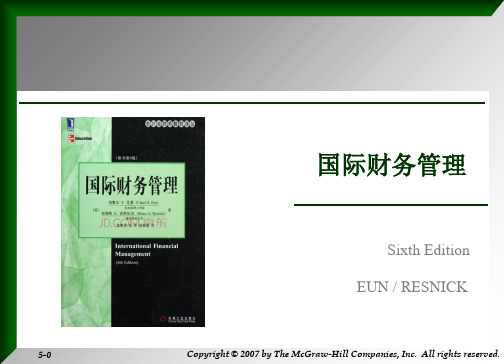
The indirect quote for British pound is:
£.5242 = $1
5-11
Copyright © 2007 by The McGraw-Hill Companies, Inc. All rights reserved.
Spot Rate Quotations
Country
USD equiv Friday
Argentina (Peso) 0.3309
Australia (Dollar) 0.7830
Brazil (Real)
0.3735
Britain (Pound) 1.9077
1 Month Forward 1.9044
3 Months Forward 1.8983
the U.S. dollar equivalent e.g. “a Japanese Yen is worth about a penny”
间接标价Indirect Quotation
the price of a U.S. dollar in the foreign currency e.g. “you get 100 yen to the dollar”
Currency per USD Friday 3.0221 1.2771 2.6774 0.5242 0.5251 0.5268 0.5290 1.2442 1.2442 1.2433 1.2412
Currency per USD The direct 0.5226 quote for
非银行交易商 nobank dealers
外汇经纪人FX brokers 俗称中介
中央银行 central banks
5-5
国际财务管理5
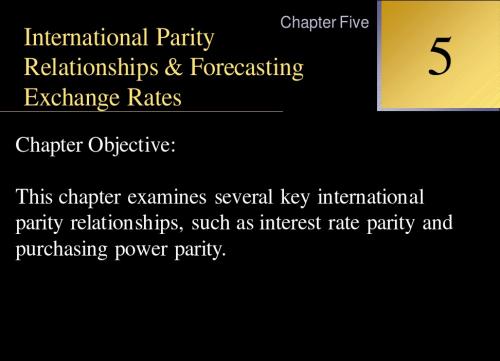
5-8 Copyright © 2001 by The McGraw-Hill Companies, Inc. All rights
Interest Rate Parity Defined
Formally,
(F/S)(1 + i¥) = (1 + ius) or if you prefer, 1 i$ F 1 i¥ S IRP is sometimes approximated as
Spot exchange rate
360-day forward rate U.S. discount rate British discount rate
McGraw-Hill/Irwin
S($/£ = $1.25/£ )
F360($/£ = $1.20/£ ) i$ = 7.10% i£ = 11.56%
5-10Βιβλιοθήκη Copyright © 2001 by The McGraw-Hill Companies, Inc. All rights
IRP and Covered Interest Arbitrage
A trader with $1,000 to invest could invest in the U.S., in one year his investment will be worth $1,071 = $1,000(1+ i$) = $1,000(1.071) Alternatively, this trader could exchange $1,000 for £ at the prevailing spot rate, (note that £ = 800 800 $1,000÷$1.25/£ invest £ at i£ = 11.56% for ) 800 one year to achieve £ 892.48. Translate £ 892.48 back into dollars at F360($/£ = $1.20/£ the ) , £ 892.48 will be exactly $1,071.
- 1、下载文档前请自行甄别文档内容的完整性,平台不提供额外的编辑、内容补充、找答案等附加服务。
- 2、"仅部分预览"的文档,不可在线预览部分如存在完整性等问题,可反馈申请退款(可完整预览的文档不适用该条件!)。
- 3、如文档侵犯您的权益,请联系客服反馈,我们会尽快为您处理(人工客服工作时间:9:00-18:30)。
英镑的美元价格 ($/¥)
DD
’D’D’ S
2.50
2.00
S 0
G’ G
D
1
1
D’ 英镑的数量
英镑的美元价格 ($/¥)
DD
S’’ S’ S
2.00
1.50
0
SS
S S’ S’
G G’
D
1
1
英镑的数量
• 二、影响汇率变动的因素
• (一)影响汇率变动的长期因素
• 1.国际收支的经常项目
• 国际收支是一国对外经济活动的综合反映, 所以对汇率的变动有直接影响
•
FR SR
SR
• (注:这里的利率和汇率都是一年期,没 有计算时间)
•或
Ix Iy
1 Iy• 上述公式常被 Nhomakorabea似地表示成: Ix Iy
• 这个公式表示远期汇率升水或贴水等于两 国之间利率的差异。
• 利率平价理论反映了利率对汇率的影响, 该理论基于这样一种假设:套利保值资金 的流动最终将两国的投资收入趋于一致。
000×1.05 = US$105 000 • 没有外汇风险。
• 方案2:投资于英国的国库券。
• 1.需要在即期外汇市场上卖出美元,买进 英镑,可兑换成£66 667。
• 2.然后,把英镑在英国的市场上投资于英 国的国库券£66 667,到期值是:
• £72 000 = £66 667×1. 08
• 这时它们之间的关系表达式是: • 其中:
FR 1 ix SR 1 iy
• FR:表示远期汇率 • SR:表示即期汇率 • 1十ix:表示一个国家的利率(或国内利率) • 1十iy:表示另一个国家的利率(或国外利率) • ix一iy:表示两国之间的利率差
• 如果用δ 表示汇率的升水(贴水)数,则:
• 3.同时做掉期交易,在远期外汇市场上卖 出投资于英国的本金和利息,1年后的收 益是:
• US $106 560 = £72 000×US$1.48/£
• (二)抵补(抛补)套利的意义
• 抵补(抛补)套利是一种保值的外汇投资 (hedged or covered foreign investment)方法, 投资者在进行即期交易时,为了规避汇率风险同 时还在远期外汇市场上进行套期保值。
• 根据利率平价理论,短期汇率波动是由本 国和外国的相对利差决定的,两国之间远 期汇率是溢价(升水)还是折价(贴水), 取决于两国之间利息之差。
• 两种交易货币短期利率的差额构成溢价 (升水)或折价(贴水)的基础,远期外 汇汇率是在即期汇率的基础上,用加减升 水或贴水的方式来计算的。如果两者的汇 率相等,既没有升水,也没有贴水,就称 为平价(at par)。
第二节 外汇市场的汇率平价关系
• 一、利率平价理论 • (一)利率平价理论的基本内容 • 利率平价(Interest Rate Parity - IRP)
理论所揭示的是利率和汇率之间的经济关 系,在某种情况下,即期汇率、远期汇率 和利息率之间存在着一种均衡关系。 • 它反映了汇率变化与利率变化之间的基本 规律,也是远期汇率的决定因素。
第5章 汇率决定理论与汇率预测
学习目标:
• 通过本章学习,应掌握以下知识要点: • 1. 自由外汇市场中汇率的决定与影响因素; • 2. 利率平价理论; • 3. 购买力平价理论; • 4. 费雪效应和国际费雪效应; • 5. 几种平价理论之间的关系; • 6. 汇率的预测方法。
第一节 市场均衡汇率的决定
• 4.各国政府的直接干预
• 各国政府的干预主要由中央银行出面,由于汇率 的变动对一个国家的对外收支、进出口贸易、资 本流动有着很大的影响,这些影响又联锁反映到 国内的生产、投资和价格等一系列问题
• 这种干预的形式有:
在外汇市场上买进或卖出外汇;
调整国内货币政策和财政政策;
在国际范围发表言论以影响市场心理;
• 国际收支的资本项目,对汇率的短期波动 影响最大。
• 虽然在外汇市场上是以国际商品、劳务交 易为基础,但更主要的,影响更大的是把 外汇作为一种金融资产来进行的交易。
• 2.利率的差异 • 利率高低会影响一国金融资产的吸引力。
• 3.市场预测心理因素 • 在外汇市场上人们买进还是卖出某种货币,
同交易者对以后汇率变动趋势的预测有关。
• 一、自由外汇市场中汇率的决定 • 在””布雷顿森林””体系下,各国都参照过去
流通中金属货币的含金量,用法令规定单位纸币 含金量,两国纸币的金平价仍是决定汇率的基础。 • 由于美元的危机,纸币不断贬值,其实际代表的 价值与法定含金量逐渐完全背离,纸币的金平价 已不能再作为决定汇率的基础,于是导致了固定 汇率的瓦解。 • 在纸币与黄金脱钩的情况下,汇率变成了浮动的 市场汇率,虽然各国政府采取不同的参与和干预 政策,采用不同的浮动方法,各国出现不同形式 的浮动汇率,但作为浮动汇率的基本特点是“市 场汇率”,即汇率象商品的价格一样,影响它的 基本要素是自由外汇市场中供求之间的相互作用。
• 投资者在比较两个国家的金融资产收益时, 不仅要考虑两种金融资产利率所提供的收 益率,而且还要预计这两种货币汇率的变 化所造成的收益差异。
例子
汇率
年利率(国库券)
SR:即期利率
£1=US$1.50 i$ (美国)5%
FR:一年远期利率 £1=US$1.48 i£ (英国)8%
• 现有100 000美元,如何进行投资? • 方案1:投资于美国本国的国库券。 • 一年后取得的收益是: • US$=l00 000×(1+ i$) =US$100
与其它国家联合进行直接的或通过协调进行间接性 的干预。
• 干预的目的是使汇率的变动对本国有利。 • 干预的结果一般会达到三种结果:
使变动剧烈的汇率趋于缓和; 使汇率稳定在某个水平上; 使汇率上升或下降到某个水平上。
• 5.各国宏观的经济政策
• 各国所制定的宏观经济政策将影响到一个 国家的经济增长率、物价波动水平、利息 率和国际收支,这些都必然影响到汇率的 变动。
• 国际商品和劳务的贸易是外汇市场上的主 要交易,它们的交易情况,影响着汇率变 动的趋势
• 2.通货膨胀 • 通货膨胀的影响是长期、间接地发挥作用 • 它还会影响国内外实际利率的预期心理,
从而影响市场参加者的外汇持有额等等
• 3.国家之间经济增长率的差异
• (二)影响汇率短期变动的因素
• 1.国际收支的资本项目
